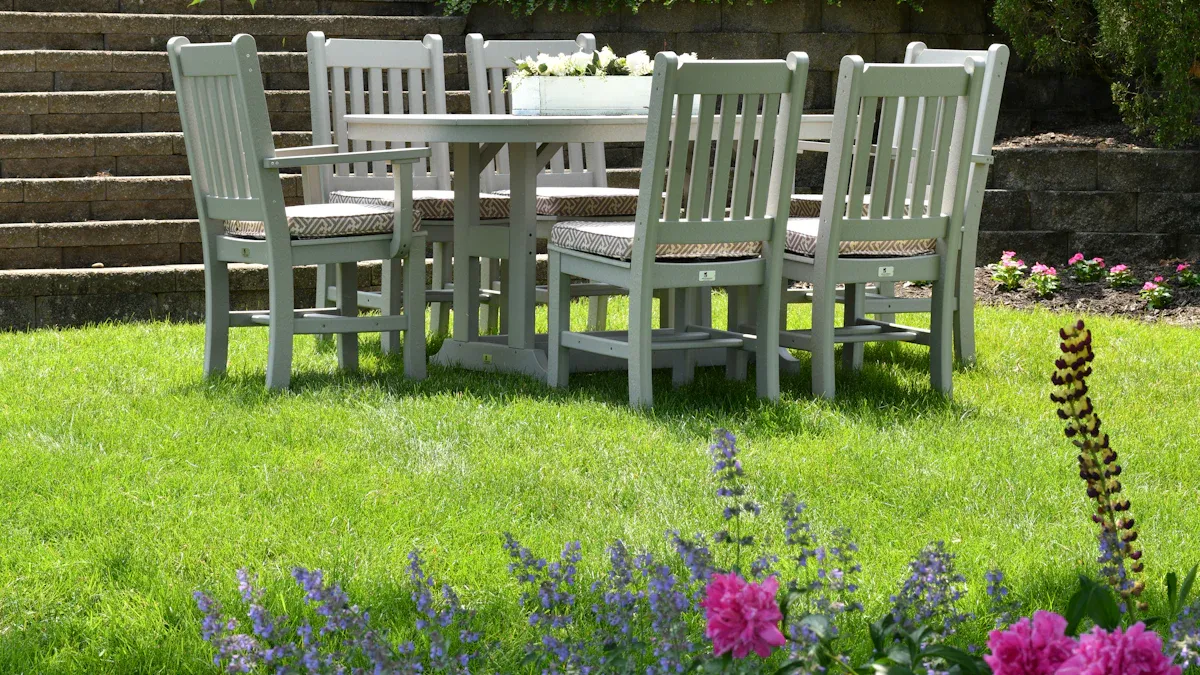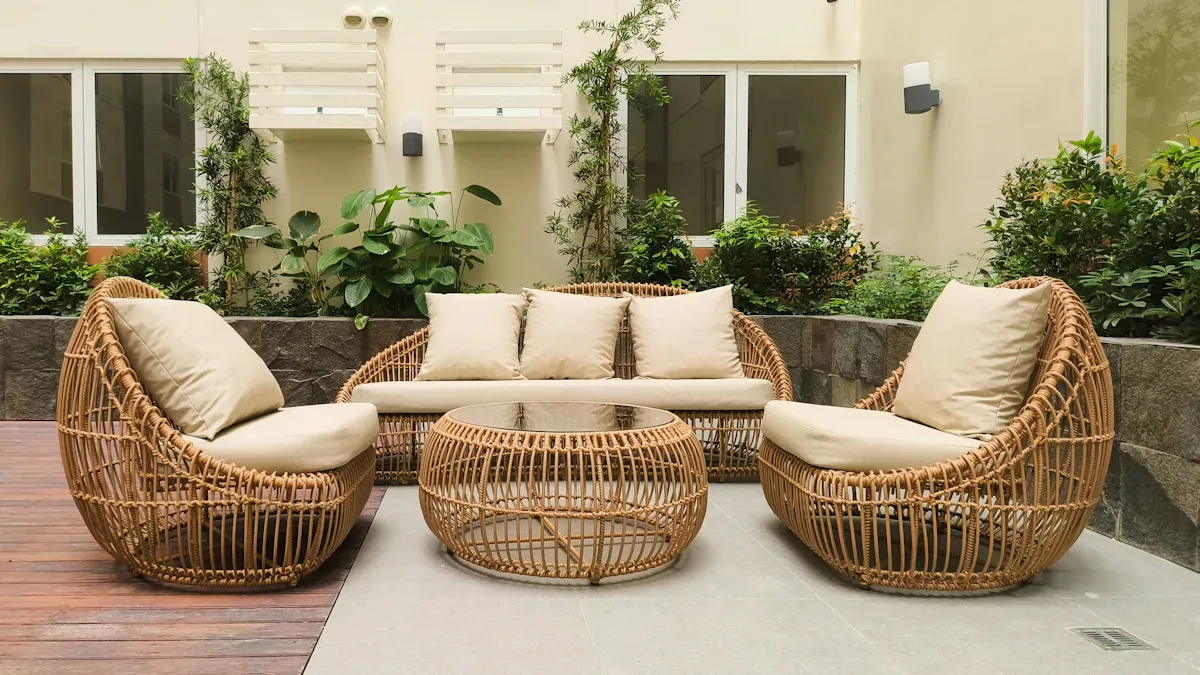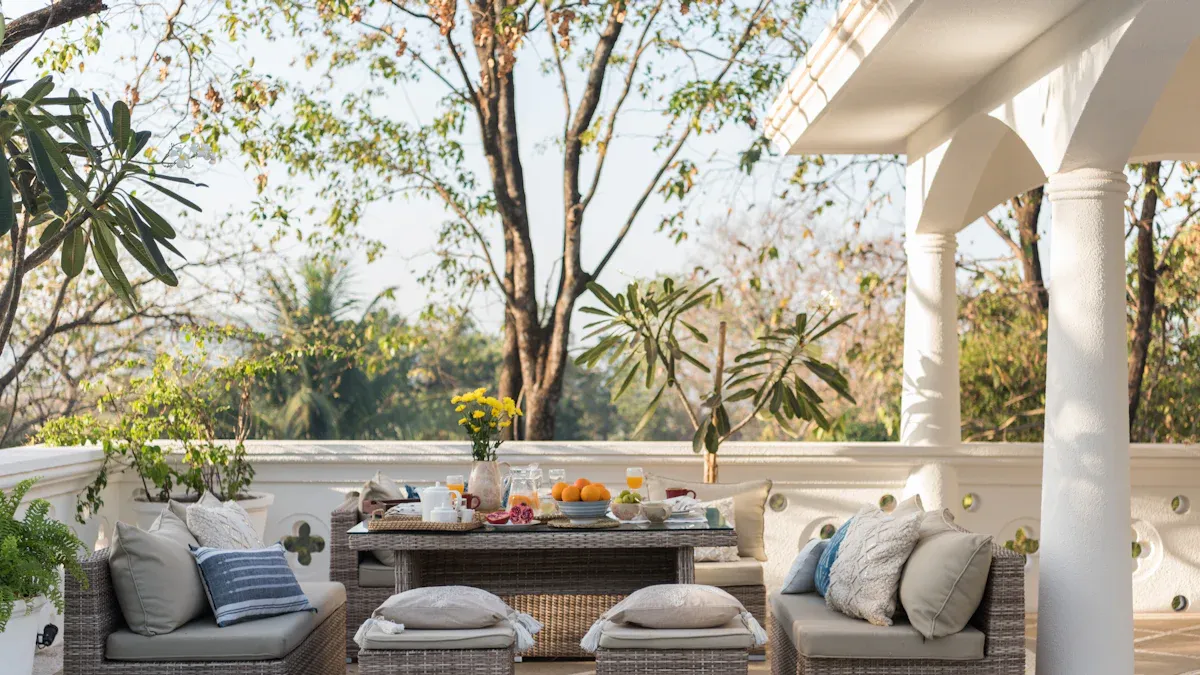
Outdoor furniture trends in 2024 emphasize style, functionality, and sustainability. Businesses are increasingly adopting modular designs and eco-friendly materials to meet customer demands. For example, seating sets are projected to dominate the market with a 37.4% share, while customizable options like an outdoor conversation sofa set enhance branding and customer satisfaction.
Key Takeaways
- Being eco-friendly is important. Green materials help your brand and attract eco-conscious buyers.
- Modular furniture is flexible. It lets businesses change spaces to fit customer needs.
- Smart tech makes furniture better. USB ports and solar lights improve customer use and interest.
Sustainability in Outdoor Furniture

Growing demand for eco-friendly materials
The demand for sustainable outdoor furniture continues to rise as consumers prioritize environmentally responsible choices. Businesses are responding by incorporating recycled, reclaimed, and renewable materials into their designs. This shift aligns with a broader societal focus on reducing waste and conserving resources. The outdoor furniture market, projected to grow from $51.17 billion in 2024 to $64.75 billion by 2029, reflects this trend. Increased urbanization and disposable income further drive the adoption of eco-conscious products.
Benefits of sustainable furniture for businesses
Sustainable outdoor furniture offers several advantages for commercial buyers:
- Environmental Impact: Using eco-friendly materials reduces the carbon footprint of businesses.
- Cost-Effectiveness: Durable designs minimize maintenance expenses and replacement needs.
- Positive Brand Image: Eco-conscious practices attract environmentally aware customers and enhance a company’s reputation.
By investing in sustainable options, businesses can align with consumer values while improving profitability.
Top eco-conscious materials for 2024
The outdoor furniture industry is embracing innovative materials that balance durability and sustainability. Leading options include:
- Recycled Plastics: Made from consumer waste like water bottles, these materials withstand harsh weather conditions.
- Reclaimed Wood: Known for its unique aesthetic and eco-friendly appeal, it supports sustainable practices.
- Natural Fibers: Biodegradable and environmentally friendly, these materials cater to the growing demand for green products.
- Biodegradable Furnishings: These items decompose naturally, reducing environmental harm.
These materials not only meet sustainability goals but also offer practical benefits for commercial spaces.
Design Trends in Outdoor Furniture

Modular designs for flexibility
Modular furniture is revolutionizing outdoor spaces with its adaptability and practicality. Businesses increasingly favor modular designs for their ability to transform layouts quickly, catering to diverse customer needs and events. For instance, outdoor restaurant furniture with modular components allows seamless adjustments to seating arrangements, ensuring optimal use of space during peak hours or special occasions. This trend aligns with urbanization and the growing demand for unique, customizable experiences in commercial settings.
Key benefits of modular outdoor furniture include:
- Flexibility: Rearrangeable pieces adapt to changing requirements.
- Space Optimization: Ideal for compact or multi-functional areas.
- Sustainability: Modular designs often incorporate eco-friendly materials, supporting green initiatives.
Curved and organic shapes
Curved and organic shapes are redefining outdoor furniture aesthetics in 2024. These designs evoke a sense of comfort and harmony, blending seamlessly with natural surroundings. Rounded edges and flowing forms create inviting spaces that encourage relaxation. This trend reflects a shift away from rigid, angular designs toward softer, more approachable styles.
Furniture with curved elements not only enhances visual appeal but also improves functionality. For example, circular seating arrangements foster social interaction, making them ideal for hospitality venues. By incorporating these shapes, businesses can create outdoor environments that feel both modern and welcoming.
Nature-inspired and minimalist aesthetics
Nature-inspired and minimalist aesthetics dominate outdoor furniture trends, driven by consumer preferences for simplicity and sustainability. Biophilic design, which integrates natural elements like wood, stone, and greenery, fosters a connection with nature and promotes well-being. Minimalist styles emphasize clean lines and uncluttered spaces, appealing to those who value functionality and eco-conscious living.
The use of biodegradable materials, such as bamboo and plant-based resins, underscores this trend. These materials decompose naturally, reducing environmental impact while maintaining durability. Businesses adopting these designs can attract environmentally aware customers and enhance their brand image.
Biophilic design emphasizes the integration of natural elements into outdoor spaces, fostering a connection with nature and enhancing well-being.
Technology in Outdoor Furniture
Smart features for enhanced functionality
The integration of smart technology in outdoor furniture is transforming how businesses utilize outdoor spaces. Features like built-in speakers, USB charging ports, and solar-powered lighting are becoming essential for creating functional and engaging environments. Built-in speakers provide high-quality audio, enhancing entertainment options for customers. USB charging ports ensure guests can stay connected by conveniently charging their devices. Solar-powered lighting offers energy-efficient illumination, extending the usability of outdoor areas into the evening while promoting sustainability. These innovations not only improve functionality but also align with the growing demand for tech-savvy solutions in commercial spaces.
Tech-driven customer experiences
Smart technology elevates customer experiences by combining convenience and entertainment. Features such as built-in speakers and solar-powered lighting enhance relaxation and usability, while USB charging ports cater to modern connectivity needs. For example, built-in speakers create an immersive atmosphere, perfect for hospitality venues or outdoor events. Solar-powered lighting ensures outdoor spaces remain inviting after sunset, encouraging longer stays. The table below highlights the benefits of these features:
| Feature | Benefit |
|---|---|
| Built-in speakers | Enhances outdoor experience with high-quality audio, increasing engagement and usage. |
| USB charging ports | Provides convenience for charging devices, encouraging longer outdoor stays. |
| Solar-powered lighting | Extends usability into the evening, promoting more time spent outdoors. |
Examples of innovative tech in 2024 designs
The outdoor furniture market continues to evolve with cutting-edge designs that blend technology and durability. Advanced features like weather-resistant electronics ensure functionality in various climates. Multi-functional designs, such as benches with storage or convertible tables, cater to consumer demand for versatility. The market, projected to reach $57.2 billion by 2034, reflects the growing interest in tech-driven solutions. Businesses adopting these innovations can create engaging outdoor environments that complement modern digital lifestyles while ensuring long-term customer satisfaction.
Durability and Weather-Resistant Outdoor Furniture
Materials built for extreme climates
Outdoor furniture designed for extreme climates must withstand harsh environmental conditions without compromising durability. Manufacturers rely on advanced materials to achieve this resilience:
- Teak wood: Naturally weather-resistant due to its oils, which repel water and resist rot.
- HDPE plastic: Lightweight, durable, and capable of lasting decades without fading or cracking.
- Aluminum: Rust-proof and highly durable, often enhanced with weather-resistant coatings.
- Synthetic outdoor fabrics: Engineered to endure heavy rain and intense heat, ensuring long-term performance.
Environmental testing, such as UV exposure and water resistance tests, ensures these materials maintain their integrity under prolonged sunlight, moisture, and temperature fluctuations. This rigorous testing process guarantees that businesses can invest in furniture built to last, even in the most challenging climates.
Low-maintenance options for commercial use
Low-maintenance outdoor furniture offers significant advantages for commercial buyers. While the initial cost may be higher, these options reduce long-term expenses by minimizing the need for repairs or replacements. Materials like HDPE plastic and aluminum require little upkeep, saving time and resources. Additionally, these materials resist corrosion, mildew, and stains, eliminating the need for frequent cleaning or chemical treatments.
By choosing low-maintenance furniture, businesses can focus on enhancing customer experiences rather than managing upkeep. This approach not only reduces operational costs but also ensures outdoor spaces remain visually appealing and functional year-round.
Importance of UV and water resistance
UV and water resistance are critical for outdoor furniture durability. Prolonged exposure to sunlight can cause fading, cracking, and material degradation. UV-resistant materials, such as HDPE plastic and treated fabrics, prevent these issues, maintaining the furniture’s appearance and functionality. Similarly, water-resistant materials like teak wood and synthetic fabrics protect against swelling, rot, and mildew caused by moisture.
Testing processes, including UV exposure and water resistance simulations, confirm the reliability of these materials. For example, temperature fluctuation testing ensures furniture can endure extreme weather changes without damage. By prioritizing UV and water resistance, businesses can invest in furniture that withstands environmental challenges while delivering long-term value.
Customization in Outdoor Furniture
Tailored solutions for commercial spaces
Tailored outdoor furniture solutions allow businesses to optimize their spaces while meeting specific functional and aesthetic needs. Custom designs align with brand identity and customer preferences, creating unique outdoor experiences. For example, bespoke seating arrangements can cater to diverse guest requirements, enhancing comfort and satisfaction. Businesses can also select custom colors and finishes to match their branding, ensuring a cohesive and visually appealing environment.
| Customization Aspect | Benefit |
|---|---|
| Tailored Designs | Aligns with brand identity and customer preferences, creating a unique outdoor experience. |
| Custom Colors and Finishes | Enhances aesthetic appeal and allows businesses to stand out in a competitive market. |
| Incorporation of Branding | Strengthens brand image and fosters customer loyalty through personalized experiences. |
| Bespoke Seating Arrangements | Better caters to guest preferences, enhancing comfort and satisfaction. |
Branding opportunities through furniture design
Outdoor furniture offers significant branding opportunities for businesses. Incorporating logos, brand colors, or unique design elements into furniture strengthens brand recognition and fosters customer loyalty. Companies like Kave Home demonstrate how a strong brand identity can drive growth. By focusing on customer-centric designs, they expanded globally and achieved a 30% revenue increase in 2023. Distinctive branding through furniture not only enhances visibility but also differentiates businesses in competitive markets.
Enhancing customer satisfaction with personalized options
Personalized outdoor furniture enhances customer satisfaction by creating memorable experiences. Businesses can offer diverse customization options, such as unique color palettes or modular designs, to meet individual preferences. This approach resonates with customers seeking tailored solutions, ultimately boosting engagement and loyalty. In 2024, the trend toward personalization reflects the growing demand for outdoor furniture that combines functionality with a personal touch, ensuring businesses remain competitive.
The 2024 trends in outdoor furniture—sustainability, innovative designs, technology integration, durability, and customization—are reshaping commercial spaces. Each trend offers unique benefits:
- Sustainability enhances brand image and attracts eco-conscious customers.
- Design innovation boosts aesthetic appeal and customer engagement.
- Technology integration improves functionality and aligns with modern expectations.
- Durability ensures long-term value, reducing replacement costs.
- Customization creates tailored experiences, fostering loyalty and differentiation.
| Trend | Impact on Success |
|---|---|
| Sustainability | Prioritizing eco-friendly materials enhances brand image and attracts environmentally conscious customers. |
| Design Innovation | Unique and appealing designs increase aesthetic value and consumer engagement. |
| Technology Integration | Smart features improve functionality and align with modern consumer expectations. |
| Durability | Weather-resistant materials ensure longevity, reducing replacement costs and enhancing customer satisfaction. |
| Customization | Tailored furniture options create unique experiences, fostering customer loyalty and brand differentiation. |
Adopting these trends positions businesses for success. For example, modular seating maximizes flexibility, while natural materials create inviting spaces that resonate with customers. Commercial buyers should begin sourcing outdoor furniture now to stay competitive and prepare for the upcoming season.
FAQ
What are the key benefits of investing in sustainable outdoor furniture?
Sustainable furniture reduces environmental impact, enhances brand reputation, and minimizes long-term costs through durable, eco-friendly materials that require less maintenance and replacement.
How can businesses incorporate technology into outdoor furniture?
Businesses can integrate features like solar-powered lighting, USB charging ports, and built-in speakers to improve functionality and create engaging customer experiences.
What materials are best for weather-resistant outdoor furniture?
Teak wood, HDPE plastic, and aluminum offer excellent durability. These materials resist UV damage, moisture, and extreme temperatures, ensuring long-lasting performance in outdoor environments.
Post time: Mar-18-2025




